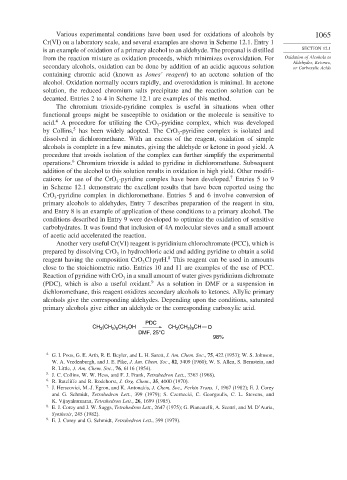Page 1089 - Advanced Organic Chemistry Part B - Reactions & Synthesis
P. 1089
Various experimental conditions have been used for oxidations of alcohols by 1065
Cr(VI) on a laboratory scale, and several examples are shown in Scheme 12.1. Entry 1
is an example of oxidation of a primary alcohol to an aldehyde. The propanal is distilled SECTION 12.1
from the reaction mixture as oxidation proceeds, which minimizes overoxidation. For Oxidation of Alcohols to
Aldehydes, Ketones,
secondary alcohols, oxidation can be done by addition of an acidic aqueous solution or Carboxylic Acids
containing chromic acid (known as Jones’ reagent) to an acetone solution of the
alcohol. Oxidation normally occurs rapidly, and overoxidation is minimal. In acetone
solution, the reduced chromium salts precipitate and the reaction solution can be
decanted. Entries 2 to 4 in Scheme 12.1 are examples of this method.
The chromium trioxide-pyridine complex is useful in situations when other
functional groups might be susceptible to oxidation or the molecule is sensitive to
4
acid. A procedure for utilizing the CrO -pyridine complex, which was developed
3
5
by Collins, has been widely adopted. The CrO -pyridine complex is isolated and
3
dissolved in dichloromethane. With an excess of the reagent, oxidation of simple
alcohols is complete in a few minutes, giving the aldehyde or ketone in good yield. A
procedure that avoids isolation of the complex can further simplify the experimental
6
operations. Chromium trioxide is added to pyridine in dichloromethane. Subsequent
addition of the alcohol to this solution results in oxidation in high yield. Other modifi-
7
cations for use of the CrO -pyridine complex have been developed. Entries 5 to 9
3
in Scheme 12.1 demonstrate the excellent results that have been reported using the
CrO -pyridine complex in dichloromethane. Entries 5 and 6 involve conversion of
3
primary alcohols to aldehydes, Entry 7 describes preparation of the reagent in situ,
and Entry 8 is an example of application of these conditions to a primary alcohol. The
conditions described in Entry 9 were developed to optimize the oxidation of sensitive
carbohydrates. It was found that inclusion of 4A molecular sieves and a small amount
of acetic acid accelerated the reaction.
Another very useful Cr(VI) reagent is pyridinium chlorochromate (PCC), which is
prepared by dissolving CrO in hydrochloric acid and adding pyridine to obtain a solid
3
8
reagent having the composition CrO Cl pyrH. This reagent can be used in amounts
3
close to the stoichiometric ratio. Entries 10 and 11 are examples of the use of PCC.
Reaction of pyridine with CrO in a small amount of water gives pyridinium dichromate
3
9
(PDC), which is also a useful oxidant. As a solution in DMF or a suspension in
dichloromethane, this reagent oxidizes secondary alcohols to ketones. Allylic primary
alcohols give the corresponding aldehydes. Depending upon the conditions, saturated
primary alcohols give either an aldehyde or the corresponding carboxylic acid.
PDC
CH (CH ) CH OH CH (CH ) CH O
2 8
2
3
2 8
3
DMF, 25°C
98%
4
G. I. Poos, G. E. Arth, R. E. Beyler, and L. H. Sarett, J. Am. Chem. Soc., 75, 422 (1953); W. S. Johnson,
W. A. Vredenburgh, and J. E. Pike, J. Am. Chem. Soc., 82, 3409 (1960); W. S. Allen, S. Bernstein, and
R. Little, J. Am. Chem. Soc., 76, 6116 (1954).
5 J. C. Collins, W. W. Hess, and F. J. Frank, Tetrahedron Lett., 3363 (1968).
6 R. Ratcliffe and R. Rodehorst, J. Org. Chem., 35, 4000 (1970).
7
J. Herscovici, M.-J. Egron, and K. Antonakis, J. Chem. Soc., Perkin Trans. 1, 1967 (1982); E. J. Corey
and G. Schmidt, Tetrahedron Lett., 399 (1979); S. Czernecki, C. Georgoulis, C. L. Stevens, and
K. Vijayakumaran, Tetrahedron Lett., 26, 1699 (1985).
8 E. J. Corey and J. W. Suggs, Tetrahedron Lett., 2647 (1975); G. Piancatelli, A. Scettri, and M. D’Auria,
Synthesis, 245 (1982).
9
E. J. Corey and G. Schmidt, Tetrahedron Lett., 399 (1979).

